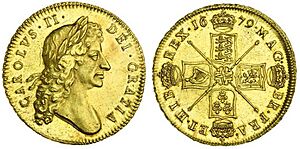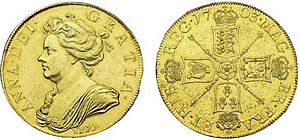Five guineas (British coin) facts for kids
The Five Guinea was a large gold coin made in Britain between 1668 and 1753. It was created using a special machine, not by hand, which made coins more uniform. This coin was about 37 millimeters wide and weighed between 41 and 42 grams, making it the biggest gold coin regularly made in Britain at the time.
Even though it's called the "Five Guinea," it was also known as a Five-pound piece. A guinea was originally worth twenty shillings (which was one pound). But its value changed a lot, much like how the price of gold coins changes today, until it was officially set at twenty-one shillings in 1717 by a Royal Proclamation.
Each Five Guinea coin had the year it was made on the back. It also had a special message carved around its edge: DECUS ET TUTAMEN ANNO REGNI. This Latin phrase means "An ornament and a safeguard, in the year of the reign..." After this, it would say the monarch's "regnal year" in Latin words. The regnal year is how many years the king or queen had been ruling. For example, for King Charles II, the year 1668 was called ANNO REGNI VICESIMO, meaning "the twentieth year of the reign." This special edge message was put on the coin before the front and back designs were added!
Many coins made before 1699 have a small picture of an elephant and a castle under the monarch's head. This showed that the gold used to make the coin came from the Africa Company. Some very rare coins from 1703 (during Queen Anne's rule) have the word VIGO under the Queen's head. This means the gold was captured from Spanish ships during the Battle of Vigo Bay in October 1702. These "Vigo" coins are super rare and very valuable to collectors. One sold for £845,000 in 2019!
Contents
Coins of Charles II
The Five Guinea coin was made every year during King Charles II's rule, from 1668 to 1684. The weight of these coins was usually between 41 and 42 grams. The designs for these coins were created by John Roettier, a famous coin designer.
On the front (called the obverse), the coin showed a detailed picture of King Charles II facing right, wearing a laurel wreath (a crown of leaves). Around his head, it said CAROLVS II DEI GRATIA, which means "Charles II, by the Grace of God." On the back (called the reverse), there were four crowned shields arranged like a cross. These shields showed the symbols of England, Scotland, France, and Ireland. Between the shields were four scepters (royal staffs), and in the very center were four linked "C"s (for Charles). Around all of this, it said MAG BR FRA ET HIB REX date, meaning "King of Great Britain, France, and Ireland" followed by the year.
Coins of James II
John Roettier also designed the coins for King James II. During his reign, the Five Guinea coins weighed between 41.5 and 42.0 grams.
On the front of these coins, King James II's head faced left, and it said IACOBUS II DEI GRATIA, meaning "James II, by the Grace of God." The back of the coin looked very similar to Charles II's coins, but it didn't have the linked "C"s in the middle.
Coins of Mary II and William III
After King James II left the throne in 1688 (in an event called the Glorious Revolution), his daughter Mary and her husband Prince William of Orange ruled together. Their Five Guinea coins showed both their heads joined together in a Roman style, with William's head on top. The writing around them said GVLIELMVS ET MARIA DEI GRATIA, meaning "William and Mary, by the Grace of God."
The back of these coins had a completely new design. It featured a large crowned shield. This shield had the symbols of France, Scotland, Ireland, and England in different sections. In the very center of this large shield was a smaller shield with the lion symbol of Nassau, which was William's family. The writing on the back said MAG BR FR ET HIB REX ET REGINA date, meaning "King and Queen of Great Britain, France, and Ireland" followed by the year. These coins weighed between 41.5 and 41.8 grams.
Coins of William III
After Queen Mary II passed away in 1694, William III continued to rule alone. Five Guinea coins were only made in the last three years of his solo reign. The designs for these coins were likely made by Johann Crocker.
The coins from William III's solo reign weighed between 41.6 and 41.7 grams. On the front, William's head faced right, and the writing said GVLIELMVS III DEI GRATIA, meaning "William III, by the Grace of God." The design on the back of the William and Mary coins wasn't very popular, so they went back to a design similar to what Charles II and James II used. This meant four crowned shields arranged like a cross, but with a small shield of the Nassau lion in the center. The writing on the back was MAG BR FRA ET HIB REX date, meaning "King of Great Britain, France, and Ireland" followed by the year.
Coins of Anne
The rule of Queen Anne (1702–1714) started with one of the most famous and valuable British coins: the "Vigo" Five Guinea piece from 1703. This coin was made from gold that was captured from Spanish ships during the Battle of Vigo Bay in October 1702. A special order from the Queen in 1703 allowed the word "VIGO" to be placed on the coins to remember this important event. Very few of these "Vigo" coins still exist today.
Queen Anne's Five Guinea coins were also made in other years: 1705, 1706, 1709, 1711, 1713, and 1714. On the front of all her coins, the Queen's face looked left, and the writing said ANNA DEI GRATIA, meaning "Anne, by the Grace of God." The back design was similar to the previous reigns, with four crowned shields for England, Scotland, Ireland, and France, separated by sceptres. In the center, there was a rose. The writing on the back was MAG BRI FR ET HIB REG date, meaning "Queen of Great Britain, France, and Ireland" followed by the year.
However, something important happened in 1707: England and Scotland officially joined together to form Great Britain (the Act of Union). This meant the design of the shields on the coins had to change. Before 1706, the shields showed England, then Scotland, then France, then Ireland. After the Union, the English and Scottish symbols were combined on one shield. So, the order became England+Scotland, France, England+Scotland, and Ireland. Also, in 1706, the central rose on the back was replaced by the Star of the Order of the Garter.
Coins of George I
George I's Five Guinea coins were only made in 1716, 1717, 1720, and 1726. These coins included his German titles (from Hanover) along with the usual British, French, and Irish titles.
On the front, the coin showed a picture of King George I facing right, with the writing GEORGIVS D G M BR FR ET HIB REX F D, meaning "George, by the Grace of God, King of Great Britain, France, and Ireland, Defender of the Faith." The back of the coin followed a similar design to before, but the order of the shields was England+Scotland, France, Ireland, and Hanover. The writing on the back was BRVN ET L DVX S R I A TH ET EL date, which means "Duke of Brunswick and Lueneburg, Arch-Treasurer and Elector of the Holy Roman Empire" followed by the year. These coins weighed between 41.7 and 41.8 grams.
It's interesting to note that the value of the guinea coin had changed a lot over the years. It had been worth anywhere from twenty shillings to thirty shillings. But in December 1717, a Royal Proclamation officially set the value of the guinea at twenty-one shillings.
Coins of George II
George II's Five Guinea coins were the very last ones of this type ever made. They were produced starting in 1729, and then in 1731, 1735, 1738, 1741, 1746, 1748, and for the final time in 1753. These coins weighed between 41.8 and 42.0 grams.
Some of the 1729 coins have the letters EIC under the king's head. This means the gold for those coins was provided by the East India Company. The 1746 coins have the word LIMA under the head. This suggests the gold came from Admiral Anson's trip around the world, though the exact connection to Peru (Lima) isn't fully clear.
On the front, the coin showed King George II's face looking left (later coins from 1746 showed an older version of his face). The writing said GEORGIVS II DEI GRATIA, meaning "George II, by the Grace of God." The back of the coin featured one large crowned shield. This shield had the symbols of England+Scotland, France, Hanover, and Ireland. The writing around it was M B F ET H REX F D B ET L D S R I A T ET E, which means "King of Great Britain, France and Ireland, Defender of the Faith, Duke of Brunswick and Lueneburg, Arch-Treasurer and Elector of the Holy Roman Empire."
See also



